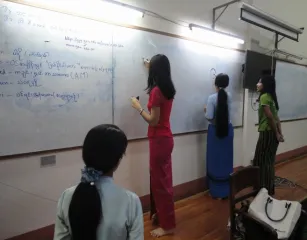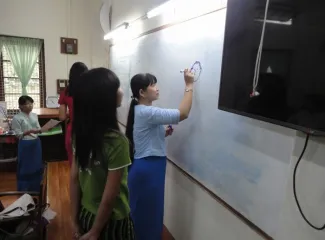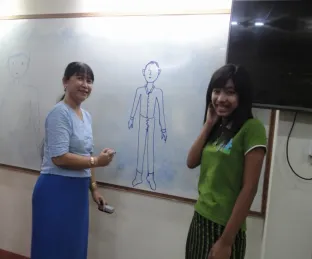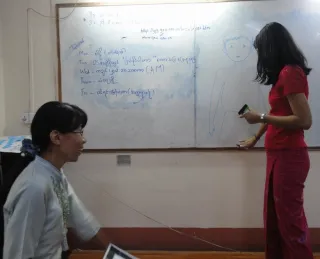2016 Activity Report
March News from the Japanese Classroom
31 March 2017
Michiko Imai, Yangon GJO
Somehow, we finished the academic term that started in December without incident with the end of term exams in the second week of March.
This term, I will part ways with the Level 4 students who have been studying together with me since June. I’m not sure whether it’s because of that, but they told the graduate student from this university who has been in charge of lessons since December as Japan Foundation Japanese language education interns told me that they wanted them to her them some Japanese songs. Being of the same generation, it must be easy for the students to ask the intern in charge of the Level 4 Kanji class.
However, the intern they asked was at a loss. Even when she asked them what kind of song they wanted to hear, the students said ‘your favourite song’. She actually likes listening to songs in English, so even when asked about her favourite song it seems that she couldn’t think of one in Japanese. So, the two of us wracked our brains on what we should do. Primary school songs are slow and the melodies are also pretty, but they use some fairly obscure words, so would be difficult for elementary Japanese language students to understand. Also, traditional Japanese songs that are too old might not be appealing to the young students. I know nothing at all about the music of today’s young people, so there was nothing I could do. When it came to songs that aren’t too old, have a melody that’s easy to sing, and have lyrics that aren’t too difficult, I couldn’t think of any. Though we hadn’t quite decided, the day that we’d promised quickly drew near, so with my own bias I decided on ‘Nada Sōsō’.
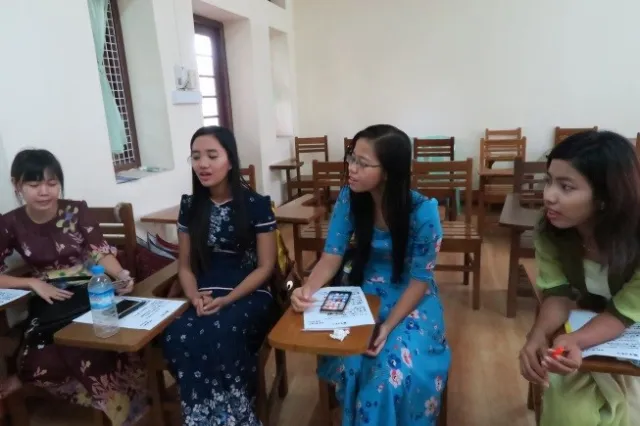
In the end, only four students came to the lesson. We handed out the song lyrics, had them check dictionaries, gave an explanation of a film that used the song in its soundtrack, but of course it still seemed to be considerably difficult. We finished a short one-hour lesson after playing the song several times on YouTube and singing it together. I’m not sure whether or not they enjoyed it though. Choosing a foreign language song suitable for elementary level learners is quite difficult, isn’t it? I can’t quite get my tongue around pop songs in Malay either, and I don’t understand the meanings, so they are beyond me.
If anybody know of a suitable song that elementary Japanese learners can understand, please let me know. I will keep on searching.
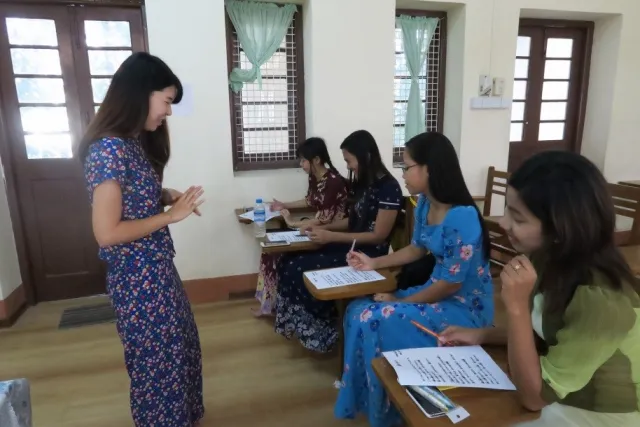
February News from the Japanese Classroom
6 March 2017
Michiko Imai, Yangon GJO
In the Buddhist country of Myanmar, there are several giant Buddha statues which each act as an object of worship for people’s strong faith. In Bago, a town 2 hours by bus or train form Yangon which was once called ‘Pegu’, there are two reclining Buddhas. The first is the Shwethalyaung Buddha, said to have been erected in the year 994, and the second is the recently-constructed Mya Tha Lyaung Reclining Buddha.
Perhaps because the eras these two reclining Buddhas were built in were also different, they have starkly different appearances.
This is the Shwethalyaung Reclining Buddha said to have been constructed in the year 994. Just like the reclining Buddhas that can be seen in the other areas in Myanmar, it has features such as white skin; large, wide eyes; and a smiling, deeply compassionate-looking calm expression.
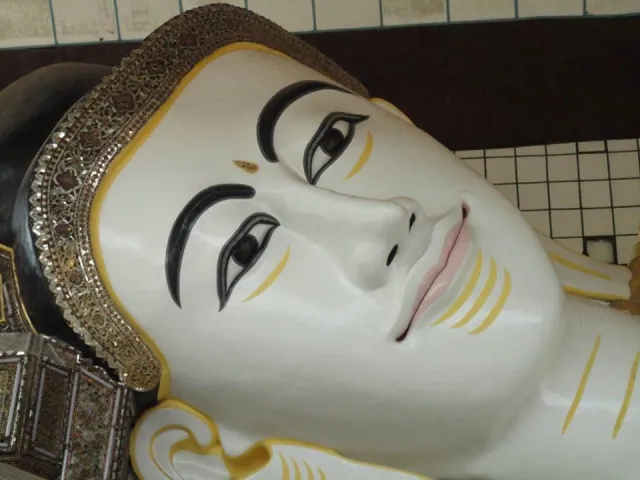
This is the Naungdawgyi Mya Tha Lyaung Reclining Buddha built in 2002 from donations from pious men and women. The iris is pale in colour, and to me it’s a Buddha I can only see as a western person.
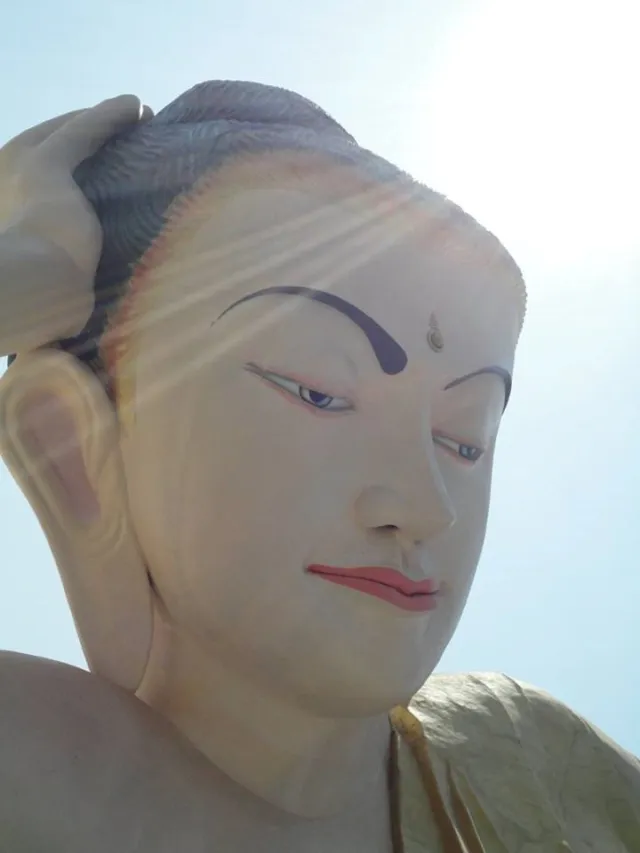
As practice using the sentence patters they had learned, I thought I would try using these two Buddhas that are well-known to the students to ask questions, but there were no replies.
Usually, there would be a lively response from several people, but that day there was silence. When I asked the students why, this time they unanimously told me the reason. In Myanmar, it is said that the Buddha is an object of respect, and should not be criticised. Regardless of the appearance, they show respect to all Buddhas, so they do not assess the appearance. When I said, while thinking it was a bit risky, “I like the Shwethalyaung Buddha more. It’s more handsome.” They students all looked perplexed. One student told me that in Myanmar, they only use the word ‘handsome’ for people. I was told that they don’t use it for the Buddha.
With that, I decided to introduce them to Akiko Yosano’s famous poem “Though a Buddha, how handsome this statue among the summer foliage”. Of course, even if I introduced them to it, an elementary level Japanese class wouldn’t be able to understand this poem, but I just told them the fact that it exists.
“Does everyone know Kamakura? In Kamakura, there is a big Buddha statue.” Here, many people nodded vigorously.
“A famous Japanese poet wrote a poem about this big Buddha, the Great Buddha of Kamakura. That person called the Buddha ‘handsome’ in the poem.” Here, everyone gasped in surprise.
“In Myanmar you don’t say that the Buddha is handsome, but in Japan it’s ok. This poem is very famous. Lots of Japanese people know it.”
Everyone looked surprised, and nodded vigorously with deeply-moved-looking faces.
We finished peacefully, with “Please do go to Kamakura and see the handsome Buddha. I’ve never been to Kamakura either, so I want to go.” “yes, we want to go.”. When you teach Japanese to foreigners, sometimes there are interesting times where you come into contact with differences in values. Along with deepening their knowledge of Japan, I would like the students to broaden their outlook as well.
January News from the Japanese Classroom
6 February 2017
Michiko Imai, Yangon GJO
The students practised using the sentence structures they had learned in class to talk about themselves. Taking a peek into what they talked about is very interesting.
The level three class prasticed using the “I want to…” structure to answer the question “If you won one hundred million kyat in the lottery, what would you want to do?”
Among students saying “I want to buy a house”, “I want to travel the world” and “I want to buy a car”, there were two or three female students who said “I want to go to Korea”, but I was a little disappointed by the honest answers. To the question “why do you want to go to Korea?” they answered things like “because I want to meet (a Korean celebrity)” and “because I want to drink Korean alcohol”. Two or three said “I want to go to Japan. I want to go shopping in Japan.”, but as someone who teaches Japanese, I wanted those wo said they wanted to travel abroad to say that they wanted to go to Japan. I was made to feel how the popularity and influence of Korea is still strong in Myanmar. I ended up with my fighting spirit burning to try my best to incorporate the appeal on Japan into the lessons more so that over half of the students will say “I want to go to Japan”.
In the level 4 class, the students practised using the sentence structure “I want to become…” to answer the question “What would you want to be if you were reincarnated?”. Over half of the country’s citizens believe in Theravada Buddhism, and in the class all the students were Buddhists who had been taught about the cycle of reincarnation, so they were able to answer the question without any problems. It was very interesting how, when asked “what nationality would you want to be born as?”, all answered “Burmese”. I wonder if that means they all have a strong sense of patriotism and are proud of their country. Next, when asked “would you want to be a man or a woman?”, I was a little surprised at how all of the students answered “if I was reincarnated I would want to be a man”. I was expecting at least half to say they want to be reincarnated as a woman. When I asked why, they said, as one, “because in Myanmar, men are valued over women”. I said, “Is that so? But Aung San Suu Kyi is a woman, so aren’t Burmese women powerful?” and they said, “Yes, that is true.” When I said, “Burmese women are powerful in the household. That’s what I heard,” they said “yes, they are powerful in the household. But men have a higher status socially”. Everyone else agreed, nodding. Having only been living in Myanmar for less than a year, I don’t know if its because they’re of this generation, or because they’re highly-educated women, or perhaps because they’re not yet fully-fledged members of society, but it was very interesting to learn that, in this country that, like all other East Asian countries, has lots of hardworking women, some young women who have barely turned twenty thinking this way.
December News from the Japanese Classroom
6 January 2017
Michiko Imai, Yangon GJO
In Myanmar, the new academic year begins in December. At Yangon GJO too, the new term began on 5th December. This term, out personnel was strengthened as part of the Japan Foundation’s Japanese language internship as graduate students at TUFS were added to Yangon GJO as supporters. Now that our personnel has grown, this term we offered a total of three classes from level one for those starting from scratch to levels three and four for those progressing form last term.
For level one, the new students had events like their enrolment ceremonies, but we were finally able to hold the orientation on 14th December. Currently, there are around 50 people enrolled, but when I counted those who actually turn up, even though there are new people coming every time, there are around 40. I think that this number will become stable after a month. Form this term, we will not be distributing things like textbooks for free, and students themselves will be buying ‘Minna no Nihongo I’, which has gained copyright and been published in Myanmar. It costs 6000 kyat (enough for around 12 bowls of mohinga, a typical breakfast noodle dish in Myanmar, or 30 bus rides), so I don’t think many students will be there just to see what it’s like.
This time students taking many various subjects are attending, and aside from the close to 40% who are taking Burmese in the literature department, there is a wide range including maths, industrial chemistry, geology, archaeology, botany, English, computer science, physics, and geography. The students are overwhelmingly female, with around 10 male students mixed in among them, and it’s funny seeing them crowding into the corner.
I wonder how many will remain after one month. Having a rich diversity of majors means that the students stimulate each other more, so I hope that as much as possible students with many different majors will persevere and survive. Including, of course, the male students.
The photo is of one of the Japanese teaching interns teaching chapter two in the level one class. The students seemed happy to learn form a cute, young Japanese teacher, and were studying enthusiastically.
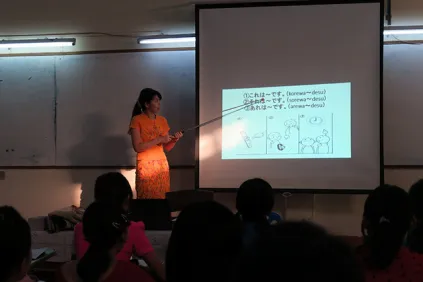
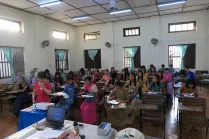
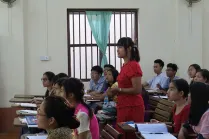
November News from the Japanese Classroom
1 December 2016
Michiko Imai, Yangon GJO
The Japanese Language Proficiency Test, which aims to measure and certify the Japanese language aptitude of foreigners, is carried out twice annually both within and outside Japan, and this year the second test will be on 4th December. There are many students studying Japanese at Yangon GJO who are taking the test, so they came to the GJO to borrow the workbooks. Three of them chose two books, and said to me “we want one (more) N4 (level) book. Er… er… such a book, um… ○◆□★☆.” They wanted to say “this kind of book” in Japanese, but they hadn’t learned how to say “this kind of …” yet, so they couldn’t. So, I asked “what kind of book? What kind of book do you want?”, and this time they didn’t know how to say the word “thin” as in “a thin book”, so the three of them held their heads in their hands and made a racket.
“A light book!”
“A light book?”
“No, a heavy book.”
When, like a pedantic old woman I said “A heavy book? Ah, well, is it this one?” and deliberately held out a massive, heavy book, the three of them conferred with each other again, going “✖✖○○?” “▽▼△□●!” “★★☆☆!?” Then, one of them suddenly remembered and excitedly shouted “thin!” and the three of them said in unison “a thin book!”. If you’re living in Japan, ‘thin and thick’ and ‘light and heavy’ are all commonly-used, essential words, but since there aren’t many opportunities to use Japanese in Myanmar, it seems that they don’t easily come to mind.
After choosing a workbook, one person borrowed the English edition of the book for Hayao Miyazaki’s ‘Castle in the Sky’. Before, another student came to borrow ‘Totoro’. It seems that the works of Miyazaki are popular even in Myanmar. Wishing more and more that they would become able to read these in Japanese, I recommended they read Yoko Sano’s ‘The Cat That Lived a Million Times’. This is a wonderful book that is written in relatively simple Japanese. It is a story about an arrogant cat in an endless cycle of death and rebirth until it finally knows what it is to love another, when it “stopped coming back to life”. In other words, it stops being reborn and dies. For the people of Myanmar, a Buddhist-majority country, the content is very easy to understand and quite touching, so I definitely wanted them to read it.
I showed them the front cover and said “everyone, read this”. They said, “Er… A hundred?”. It seems they forgot the “万” (ten thousand) in “100万回”, so the three started another discussion.
“Huh… we’ve already learned this. Look!”
“Hmm… Hmm…”
After a minute’s worth of groaning,
“Ah, ‘man’?”
Next, they couldn’t read ‘回’ or ‘生きた’, so I finally gave them a hint by telling them that ‘100万回生きたねこ’ was read ‘hyaku man kai ikita neko’, and then everyone understood the meaning. I strongly recommended they read it once the test was over. Even so, if they can’t remember basic adjectives like ‘thin’ and heavy’ and simple kanji like ‘万’, ‘回’ and ‘生きる’, I don’t know whether the N4 test will go well.
The amount you come into contact with and want to come into contact with Japanese outside the classroom is key to learning Japanese, so I felt the strong need to bring in books and DVDs in simple Japanese to win over the interest of Burmese students.
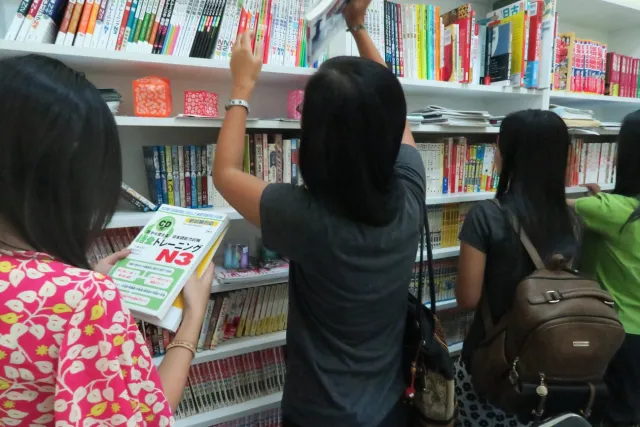
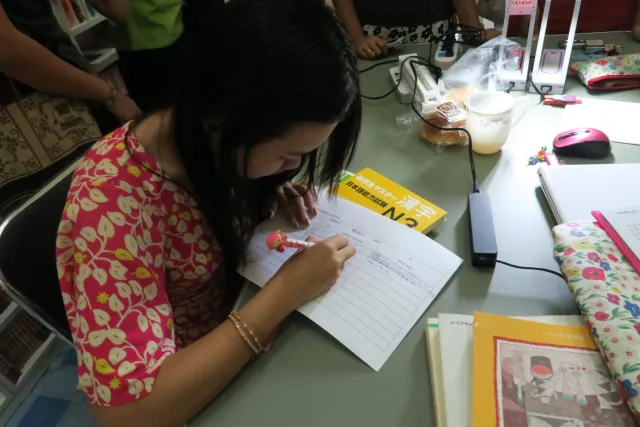
October News from the Japanese Classroom
3 November 2016
Michiko Imai, Yangon GJO
Right now, the University on Yangon is in the middle of its summer holiday, and there are no Yangon GJO Japanese lessons. So, I would like to list a few things unrelated to lessons.
At Yangon GJO, the Japanese and English books donated to the University of Yangon from TUFS now total to over 1,200. The books cover a wide range, from Japanese Language Proficiency Test workbooks to introductions to Japanese society and culture, travel guides, picture books, novels and so on. However, unfortunately it seems that not many people know about this library, as since I took up this position only one person has come to borrow books.
So, the other day I introduced the library to a teacher at the literature department, who many times has helped me at Yangon GJO with things such as visas. This teacher has a great interest in Japanese and has been self-studying Japanese with an online learning site and buying Burmese-Japanese dictionaries. When I said “we can lend three books for up to two weeks to University of Yangon teachers and students”, he enthusiastically searched through the bookcase and took two books out to borrow. He has finished reading the books in the photo, and is in the middle of tackling his third. I also recommended Japanese manga for Japanese language study, as it is incredibly interesting, often being philosophical and dealing with historical figures, so it is worth reading.
Up to now, the posters for the library have been in Japanese, but I hope to put the Burmese translation up on the notice boards in the halls where it will be easy to see, and to have lots of people come to borrow books. It would be a shame if no one comes, as this wonderful collection would go to waste.
One more good thing has happened. The teachers at the literature department are always helping me at Yangon GJO will all sorts of things, and the teacher who helps me with things like Yangon GJO’s drinking water and electricity told me that from December, he will be studying Japanese. I hope to do my best to steadily increase the number of learners of Japanese at the University of Yangon among both students and teachers.
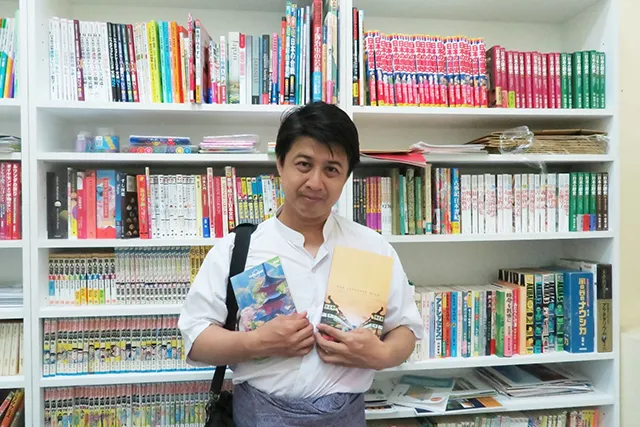
September News from the Japanese Classroom
5 October 2016
Michiko Imai, Yangon GJO
Yangon GJO’s Japanese classes were successfully brought to completion in August, and on 1st and 2nd September we had the end of term exams for levels two and three.
Of the 18 people who took the level two midterm exam, 14 took this exam, all of whom passed. In the class, there were students specialising in law, chemistry, international relations, computer science, zoology, geology, archeology, and literature. After class, each came from their own department buildings to the literature department building specially to take the lessons, and that enthusiasm is admirable.
As for level three, all of the students who took the midterm took the exam, and all passed. Aside from one student specialising in geography, all specialise in literature. As a matter of fact, in this class aside from the students there were two literature teachers as well as one teacher from another university attending. Since they were busy with their jobs, the teachers, who had the tendency to be slow to understand and revise more so than the students, were always receiving help from the students. When they were paired up, the students and teachers suddenly switched position, and the students were always respectful and thoroughly reliable towards the teachers. We had a harmonious class, with the teachers innocently practicing almost as though they had returned to their student days, and the dependable students.
Thanks to so many people, I was able to successfully complete one term of Yangon GJO’s Japanese language unit. I’d like to take this opportunity to thank the two international students of Burmese from TUFS who, when I had just taken up this position and was unfamiliar with Yangon, gave me encouragement and support and provided me with teaching assistance.
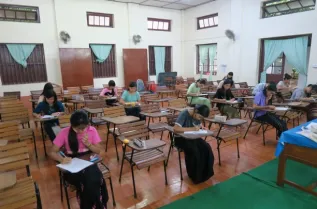
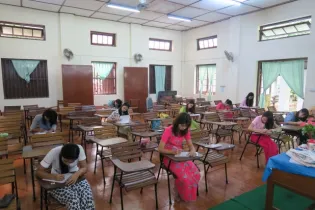
Students taking the end of term exam
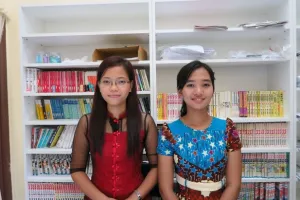
third year Chinese student teaching assistants from the University of Yangon
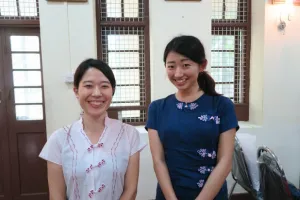
Burmese exchange student teaching assistants form TUFS
■■■News From the Japanese Classroom (August, 2016)■■■
Yangon GJO’s Japanese classes, which started in June, were successfully brought to completion in August.
In the last class of the term at the end of August I had the level three students write simple phrases. The students had learnt up to the sentence structure “my hobbies are…” in chapter 18 of “Minna no Nihongo I”, so they did presentations which included the example sentences about their own hobbies. 12 students attended on the day. In the class, the most common hobbies were watching films and travelling. As for the more peculiar hobbies, there was “buying fruit in department stores”. Upon hearing this, everyone burst out laughing. After films and travelling, the next most popular hobbies were reading, cooking, listening to music, drawing pictures and taking photos, and I was surprised to see nobody choose sports. Perhaps it’s because in Yangon’s hot weather you sweat enough already without going to the trouble of playing sports. You often see boys finding a suitable place and amusing themselves by playing chinlone (a game resembling football that uses a ball woven from rattan), as well as people walking on campus early in the morning here and there, but it seems this class just prefers not to.
During lessons I didn’t give the students any instruction aside from using the sentence structures and explaining the a little, so I was anxious about what kind of presentations there would be, and while all of them had some grammar mistakes they were very interesting and well-put together. I would like them to learn even more vocabulary and grammar and become able to say all kinds of things about themselves in Japanese.
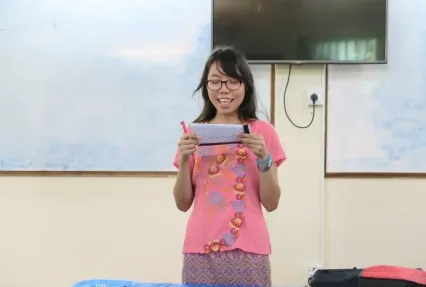

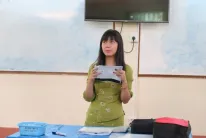
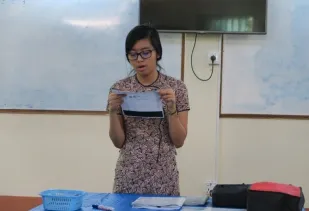
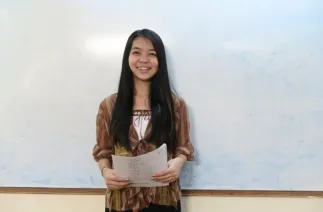
■■■News From the Japanese Classroom (July, 2016)■■■
One month has passed since the start of the new term, and I was finally able to begin kanji lessons. The level two class was for complete beginners and the level three class went up to chapter 12 in the textbook.
Just to make sure, before the level three class began from chapter 13, we went over chapter 10. Any problems came to light through the steps of submitting the revision pages of chapter 10 as homework and checking through the answers.
There were many students who, despite somehow being able to get through number one, didn’t do number two onwards. As for number three, even the honours students couldn’t manage and came without doing it. When I asked what had happened, the students said “We understand the Japanese readings of the characters, but we haven’t learnt the Chinese readings”. When I asked what chapter they had learnt up to, they said “chapter 3”. Because they had no foundation, even if I were to teach them the radicals there would be no way they’d be able to remember them, so we hurriedly went over the chapters from chapter 4.
The photographs are of the students writing kanji form chapter 5 that the teacher read out in a random order. Because the students who came up to the front inevitably struggled when a Chinese pronunciation came up, their classmates who were sitting down would give the hints by saying the meaning of the kanji in Burmese, so Burmese was banned. For example, when a student didn’t know that the “moku” in “mokuyōbi” (Thursday) was written with the character “木” (meaning tree, pronounced “ki”), a small but enthusiastic voice would throw them a line by saying “Saitpain! Saitpain!” (the Burmese word for “tree”). So, I tried to get them to use Japanese as much as possible by saying “please don’t use Burmese. Say the Japanese pronunciation”. After doing so, one of them desperately flipped through the textbook shouting “ki… ki…” and was able to successfully write the word for “Thursday”.
At first, there were undecipherable characters that looked more like something an alien might write than kanji, but I’m glad to say that the students gradually got much better.
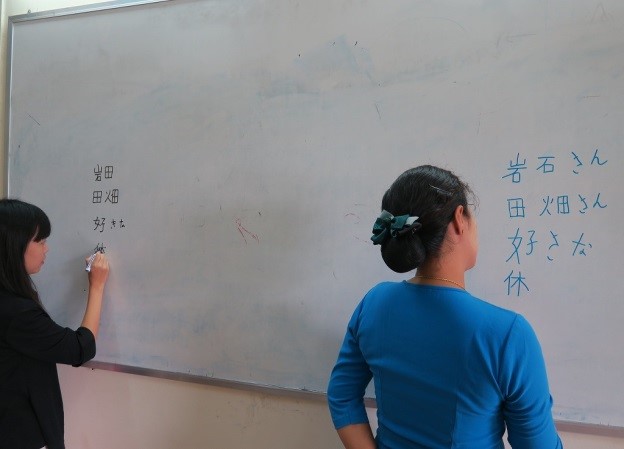
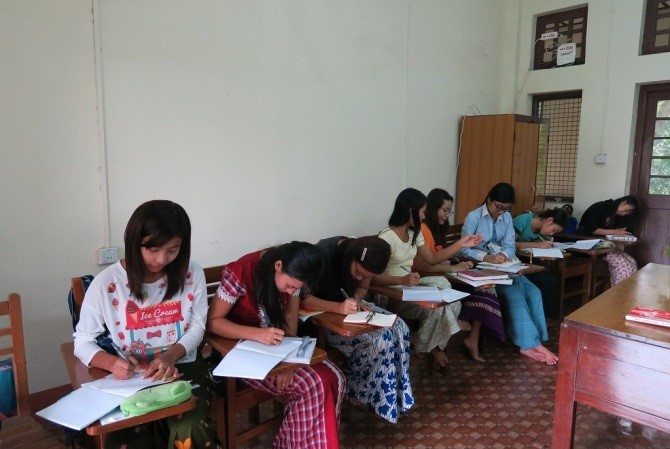
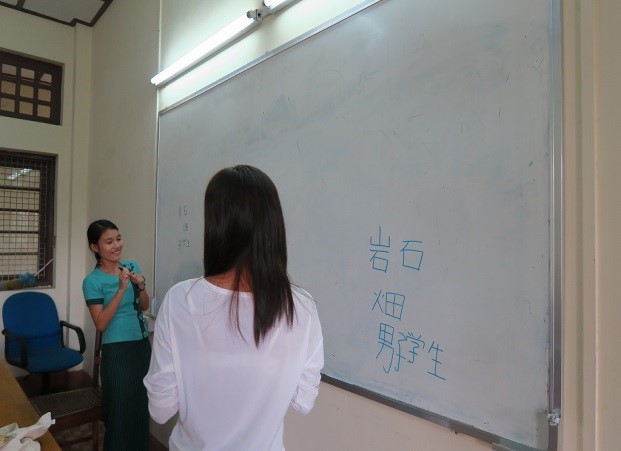
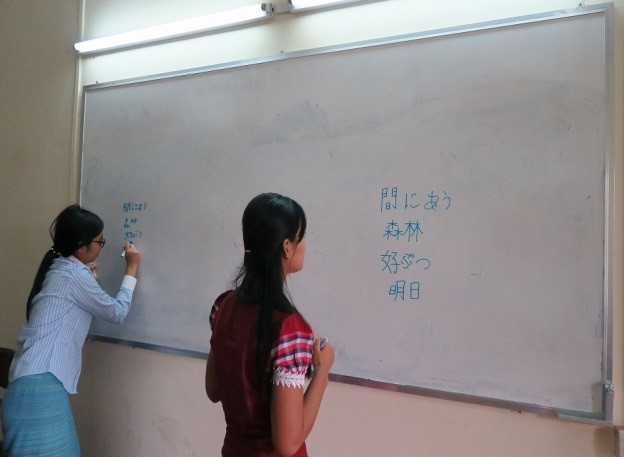
■■■News From the Japanese Classroom (June, 2016)■■■
During the rainy season here at Yangon it heavily rains almost every day. Even now rain is pouring down almost like a waterfall making it almost impossible to step outside. Due to the heavy rain we experienced a power cut and because you cannot use the electricity in the office or in the classrooms some of the teachers from Myanmar were determined to carry on teaching and put chairs out in the hallway.
Among this, on the 13th of June, just 2 weeks after the final period of lectures started, the Japanese language class held by the GJO at Yangon University began. For this semester, the Level 2 classes are held on Monday and Thursdays from 15:30 until 17:00 and the Level 3 classes are being held at the same time on Tuesday and Fridays. For the first week, in order to awaken the Japanese knowledge sleeping in the students minds I chose to cover self-introductions and revise everything we had previously covered. For the self-introductions I had the students talk about their name, major, where they live, their hobbies and dreams for the future but when taking about dreams for the future, everyone gave exemplary answers such as “I want to be a teacher” and “I want to become a researcher” which surprised me. Nobody said “I want to become rich” or “I want to travel around the world”. I am really curious whether it is just the students at Yangon University or other people from Myanmar are also the same. There are also teachers from the Literature Department participating in the classes but even all the teachers said such things as “I want to complete good research” or “I want to write a good research paper” which showed just how serious and dedicated to their work they are.
From the following week each of the classes started using “Minna no Nihongo 1” starting from either chapter 10 or chapter 16. Steadily everyone has begun to use their voices and have been saying the answers full of energy during the grammar pattern practice. It was during this that I realized the special trait that people from Myanmar have when they speak Japanese. People from Myanmar pronounce the “a” from “an” with a sound which is in between “a” and “e”. For example when they say “mikan (orange)” it sounds like “mikian” and “satou-san” would become “satou-suian”. It would be a shame if due to this pronunciation their Japanese could not be understood very well after practicing as hard as they could in order to be able to speak with the correct grammar so now during every class the teacher demonstrates the pronunciation and the students must repeat. At first the students laughed and seemed a little embarrassed but now when they pronounce words that contain the “an” sound they purposefully say it clearly in a loud voice.
In the final week of June the Level 3 class was using the grammar patterns “A-san wa kami ga nagai desu” and “B-san wa se ga takai desu” from chapter 16 to practice describing the features of people’s bodies. For first hand practice they got into pairs where one person would describe the features of their boyfriend/girlfriend etc using the practiced grammar and the other person would listen and then draw a picture to match the description.
Everyone had drawn very handsome and good looking partners.
Students drawing pictures of their partners boyfriend/girlfriend
